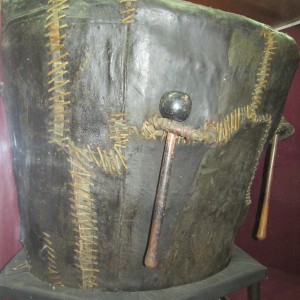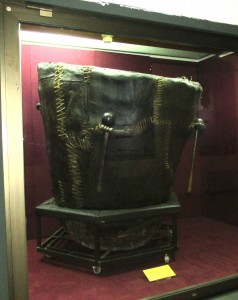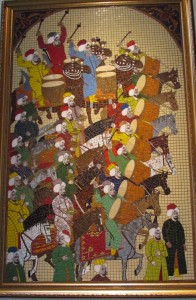Instruments in Istanbul
In the first of a series of posts on ‘What I did over the summer vacation’, postgraduate Anna Borg Cardona, who is researching instrument-making and musical culture in 17th-century Malta, tells us about the instruments she encountered on her trip to Turkey:
 Destination Istanbul – finally! This was the magical Constantinople which attracted so many Europeans in the 19th century. This was the city which inspired foreign artists, including the Maltese Amodeo Preziosi, whose brightly-coloured lithographs of daily life in the 1850s I knew so well. This was, above all, home of the renowned Ottoman Janissaries and their military bands.
Destination Istanbul – finally! This was the magical Constantinople which attracted so many Europeans in the 19th century. This was the city which inspired foreign artists, including the Maltese Amodeo Preziosi, whose brightly-coloured lithographs of daily life in the 1850s I knew so well. This was, above all, home of the renowned Ottoman Janissaries and their military bands.
We stayed in the historical part of the city close to the magnificent Blue Mosque and the Ayasofya mosque which was originally the Basilica of early Christendom. We visited all the bazaars and the main sites but I will share with you just one very special object seen in Istanbul – a huge type of kettle drum, known as kös, which is exhibited in the Military Museum. This museum is the home of many of the old mehter (military band) instruments and the place where one can also see a modern version of a Janissary band in action.
Malta is a little island in the Mediterranean and its history was made up of constant encounters with the Turks. All our legends and tales are based on such encounters. Our history books talk of a ‘Great Siege of 1565’ in which the Turks were rebutted and the great Admiral Dragut (Turgut Reis 1485-1565) was defeated. So, it was extremely disappointing for me to find that there was absolutely no mention of this ‘Great Siege of 1565’ anywhere in the Museum. It was clearly greater to us Maltese than it was to the Ottoman Empire! But it did happen and diaries of the time give intricate details of the deafening noise created by the Turkish bands as they approached the Maltese islands. One description comes from the diary of Francisco Balbi di Correggio (1505-1589) first published in Spain less than two years after the attack. He described how the Grand Master of the Order of St John (then governing the Islands) ordered the beating of drums to shut out the frightening and disheartening sound of the approaching enemy’s drums and other musical instruments:
As is their custom, they [the Turkish invaders] brought with them many bugles, trumpets, drums, bagpipes, and other strange instruments[…]. The Grand Master gave orders for all our drums to be beaten[…]. The general assault began at dawn. So great was the noise, the shouting, the beating of drums and the clamour of innumerable Turkish musical instruments, that it seemed like the end of the world.
(Francisco Balbi di Correggio, The Siege of Malta 1565 (Malta: Progress Press, 1965), pp.49, 81).
 There are several mehter instruments in the Miltary Museum but the kös dating back to the 16th century kept me riveted for several reasons. This is an incredibly large drum whose body is covered in dark leather. The different skins are tightly hand-stitched together around the body with large, even stitching. The drum has one beating surface and a body which narrows at the base and is at present supported on a stand. There are also leather loops on the side into which the large wooden beaters could be inserted when not in use. Since there are more than two beaters, there must have been more than one person beating this drum. Its height, though I couldn’t measure, must be around 5 feet. The information on the label informs viewers that this drum was used by Suleyman the Magnificent in 1526 in the battle of the Mohaç. I imagined that this huge instrument alone must have created an overpowering resonance which would doubtless have terrified the enemy. It set me musing whether this could also have been used aboard Ottoman galleys in the attacks on Malta, and particularly in the siege of 1565 when Suleyman was still Sultan of the Ottoman Empire. This together with shrieking zurnas (oboe-like instruments), brass trumpets (boru), cymbals (zil), yet more different drums (davul and nakkara) and war-like shouting would indeed have seemed ‘like the end of the world’.
There are several mehter instruments in the Miltary Museum but the kös dating back to the 16th century kept me riveted for several reasons. This is an incredibly large drum whose body is covered in dark leather. The different skins are tightly hand-stitched together around the body with large, even stitching. The drum has one beating surface and a body which narrows at the base and is at present supported on a stand. There are also leather loops on the side into which the large wooden beaters could be inserted when not in use. Since there are more than two beaters, there must have been more than one person beating this drum. Its height, though I couldn’t measure, must be around 5 feet. The information on the label informs viewers that this drum was used by Suleyman the Magnificent in 1526 in the battle of the Mohaç. I imagined that this huge instrument alone must have created an overpowering resonance which would doubtless have terrified the enemy. It set me musing whether this could also have been used aboard Ottoman galleys in the attacks on Malta, and particularly in the siege of 1565 when Suleyman was still Sultan of the Ottoman Empire. This together with shrieking zurnas (oboe-like instruments), brass trumpets (boru), cymbals (zil), yet more different drums (davul and nakkara) and war-like shouting would indeed have seemed ‘like the end of the world’.
 The kös is kept behind glass so the photographs I took are bound to have some reflections, but are worth showing nevertheless.
The kös is kept behind glass so the photographs I took are bound to have some reflections, but are worth showing nevertheless.
A modern mosaic in the Military Museum, a copy of an 18th century painting found in the Topkapi Seraglio Museum Library, shows the band in action. Three kös players are seen in the back riding camels. Each is vigorously playing a pair of drums but they are much smaller than Suleyman’s 16th century kös.

